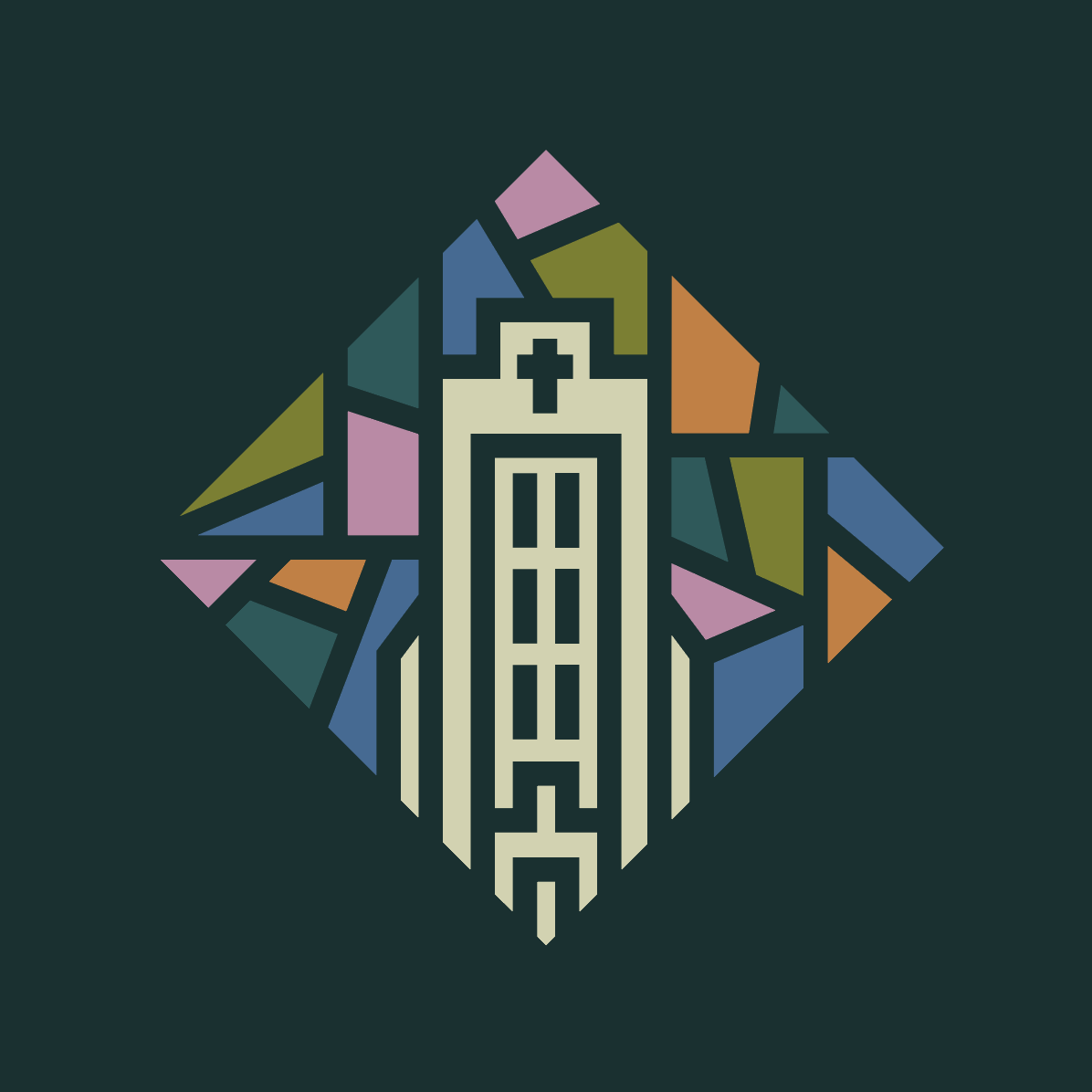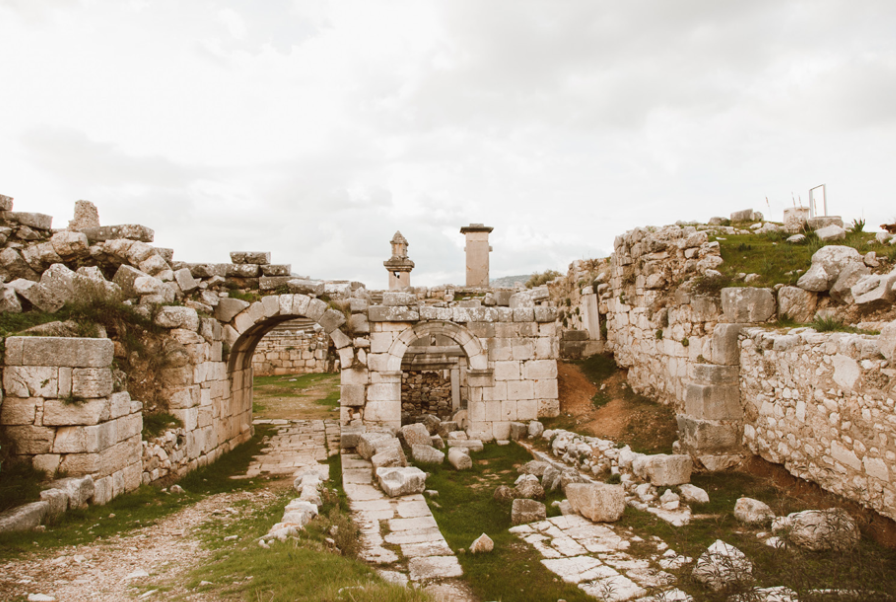
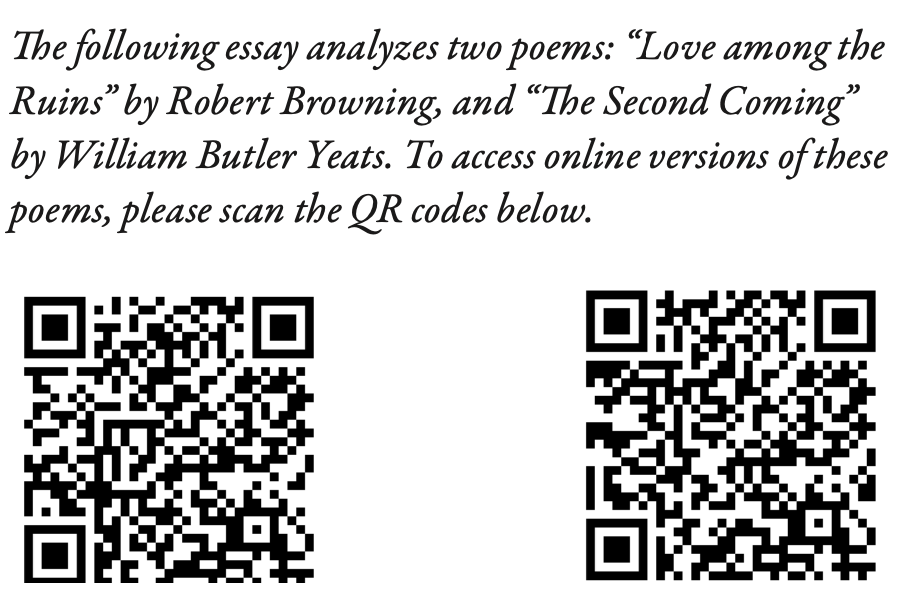
Empires rise and fall. During the 19th century, the British Empire was the largest and most powerful political and economic superpower in the world, earning the saying, “The sun never sets on the British Empire.” Other nations looked to England for guidance on progressive reforms and economic trends, such as industrialization, the abolition of slavery, and women’s suffrage. Despite these positive changes, various British writers, including Robert Browning and William Butler Yeats, used their work to critique immoral practices the British Empire maintained during this time period. One of the foremost topics of criticism was the evolution of British and Western civilization society and moral regression between the Victorian era and the early 20th century.
The trajectory of religious thought and practice in Britain played a large role in the development of society and, in turn, the establishment of Browning and Yeats’ perspectives on society’s changes. While these poets lived and wrote during different eras (those being the Victorian period and the early 20th century, respectively), religion interested both writers deeply and heavily shaped their work. Though both men’s experiences with religion shaped their worldviews, their disparate conclusions on the character of God and the truth of Christianity led to differing criticisms and solutions to the regressing moral state of British society. Edward Berdoe describes Browning as having believed that “the Son of God made man for us solves … all the hard problems of existence.”1 This foundation, which implies a traditional understanding of Jesus Christ as the savior of humanity, set a framework through which Browning’s poems can be viewed.
Alternatively, Yeats’ relationship with faith is seen as heterodox from the historic Christian view in his poem “Leda and the Swan.” This poem, which depicts Zeus’ rape of a woman named Leda from Greek mythology, portrays God not as the ultimate moral authority but rather as “filled with divine power and knowledge” yet “still the brute blood of the air.”2 This notion contradicts the traditional doctrine that God is both almighty and beneficent. The image of a majestic bird violating a human for its own pleasure suggests that God, who is still omnipotent, can use his power for evil. These beliefs about God undergird Yeats’ application of Christian images that occur throughout his poetry. As exemplified in Browning’s “Love among the Ruins”3 and Yeats’ “The Second Coming,”4 respectively, Browning’s view of the Christian God as the source of morality makes human sin and selfishness the end to society, whereas Yeats’ non-traditional religious beliefs lead to his depiction of Christian morality as something that has led culture to its downfall.
Both poets use Christian imagery and allusions, but their respective references point to different problems within British society. “Love among the Ruins,” published by Browning in 1853, creates a picture of society reminiscent of biblical and classical civilizations. Robert Adger Law connects the reservation of “thousand chariots” from line 77 to 1 Chronicles 18, where David took from King Hadarezer a thousand chariots and later reserved a hundred chariots.5 These chariots, which are “gold of course” in Browning, invoke a wealth and militaristic influence boasted by biblical kings. Additionally, Browning’s description of those who “built their gods a brazen pillar high as the sky”6 and had a “lust of glory [that] pricked their hearts up”7 calls to mind the story of the Tower of Babel in Genesis. Similar to the tower-builders’ pride and idolatry, which led to their inability to communicate with each other, Law comments that while many have taken the background of Browning’s poem as an allusion to the fall of Rome, he sees the image of a civilization as possibly reminiscent of the biblical kingdoms of Babylon or Jerusalem.8 Babylon, a symbol of decadence in the Bible, seems to run parallel with the “whole centuries of folly, noise, and sin” that Browning says plagued the city in his poem.9 The references to ancient societies that slowly degenerated because of their immoral and arrogant actions seem to serve as a cautionary warning to the reader and the current society in which one finds oneself, which would have most likely been Victorian England during the time of the piece’s publication. The final line of “Love among the Ruins,” “Love is best,” departs from the narrative perspective the poem took on before and serves as a moral declaration from the poet.10 Informed by Browning’s belief in the personal Christian God who took on flesh to live, die, and resurrect for humanity, this line takes on a meaning akin to Paul’s writing from 1 Corinthians 13: love is the greatest among the three theological virtues of faith, hope, and love.
On the other hand, Yeats’ use of biblical and religious references in “The Second Coming” points to the idea that Christianity as a value system is outdated, and society needs to reach a new inflection point to move forward. The title itself comes from a biblical belief: Yeats sets a scene of moral decay and chaos similar to Revelation’s view of the end of the world and then conjectures that an atypical Second Coming is coming soon to make things right. Richard P. Wheeler quotes Harold Bloom on the singularity of Yeats’ spirituality in the poem: “its particular twistings of Christian myth make the poem ‘a masquerade of Yeats’ Gnosticism in Christian terms.’”11 Yeats frames his understanding of these Christian themes with his famous symbol, the gyre.12 This device serves as an image of the turning and widening timeline of human society. Resembling a spiral, the gyre is defined by cycles that have significant inflection points at the 2,000-year mark. For example, the years around 2000 B.C. and 3–4 B.C., which is when Jesus was said to be born, served as inflection points on the human timeline. Yeats believed another key event was bound to occur in A.D. 2000, which serves as the background for his poem.
The title invokes the biblical concept of Jesus’ second coming, which in Christian theology serves as an event that will make all things right. Yeats takes this well-known doctrine and turns it on its head, likening the two thousand years before the birth of Jesus as “twenty centuries of stony sleep [that] were vexed to nightmare by a rocking cradle.”13 Yeats’ distrust of the goodness of God provides insight into the negative terminology he uses surrounding Jesus. As opposed to a Christian love serving as the solution to issues in society, Yeats asks for another cultural zeitgeist to replace the Christian tradition that he believes has had an unfavorable impact on British society. In the final line of “The Second Coming,” Yeats expresses desire for something to free society from this tradition by the year 2000: a “rough beast [whose] hour [has] come round at last” and “slouches towards Bethlehem to be born.”14 This beast, known as the antichrist in the Bible, is traditionally viewed as the antithesis to the love and truth of Christ, but here Yeats suggests he is eagerly anticipating the changes this beast will bring to society. This desire for a post-Christian society runs counter to Browning’s argument that the issues plaguing Britain are in fact aberrations from Christian values.
In addition to their use of biblical allusions, both poets impart their own views on society through the structure they build into the text. “Love among the Ruins” takes on an oddly structured narrative throughout. Though the poem makes clear that its subject is a once-glorious ancient city, Browning chooses an unconventional timeline, framing the story with a weathered narrator showing the ruins of this city to a younger pupil. This relationship between the speaker and the listener of the poem allows Browning to achieve his goal of providing a moral warning to the reader. This unique point of view and the initial context that sets up this narrative add to its effectiveness. Johnstone Parr writes about the possible location of the poem, an ancient pre-Roman city in present-day Italy called Tarquinia, “which for four hundred years before the founding of Rome in 753 B.C. held undisputed sway over all central Italy.”15 Parr emphasizes that this city was paramount in influence over the Italian peninsula at the time but quickly fell into disrepair and obscurity in the coming centuries because of the rise of Rome. She also mentions the parallels between Browning’s city and biblical cities in that the ruins of these cities were not found until the mid-nineteenth century “in spite of their Biblical importance.”16 Similar to these cities, Browning makes a point that his city is long forgotten. After describing a city spread across “miles and miles” that once boasted a “domed and daring palace” with protruding and noticeable spires, Browning later declares, “Now — the country does not even boast a tree.”17 The usage of the word “boasts” suggests the people of this grand city had an arrogance that led to a later humiliation. Parr’s commentary helps draw attention to the major arc throughout Browning’s poem that civilizations may be sure of themselves and have many physical possessions — such as vast amounts of land and a strong military — but it is their sound morality that, in actuality, keeps them stable and prosperous.
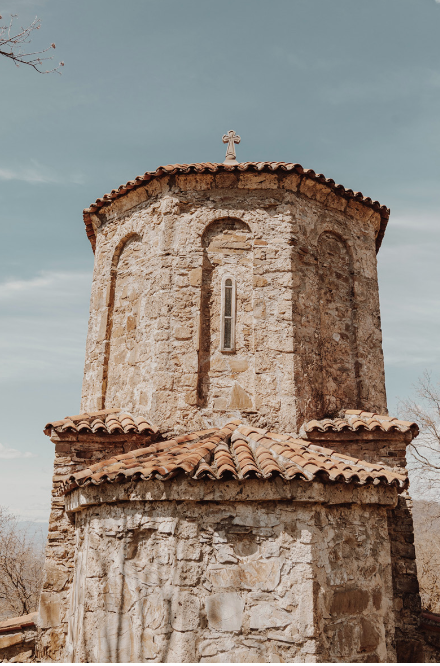
Yeats’ narrative employs his own gripping form, which, rather than telling a moralistic fable of an ancient detailed city, begins with a religiously motivated chaos and ends with a look forward to a perceived evil for the cure. Paul D. Deane notes the poignant use of metaphor in Yeats’ work: “No one can remain unmoved by the horrific sequences of metaphors painting image after image of anarchy leading not to the Second Coming of Christ.”18 Not only does Yeats not present Christ as the solution to Britain’s immorality, but he even plays with the reader’s expectations and deliberately subverts them to prove a point. Yeats presents the reader with an initially jarring image of time twisting as a gyre and declares that “mere anarchy is loosed upon the world.”19 This image of darkness and anxiety where “innocence is drowned”20 leads to a charge that the Second Coming has occurred. Yeats’ structure here places the work outside of the Victorian era and into a new style of poetic storytelling. In line with his religious beliefs, Yeats does not end “The Second Coming” with a moral in the same way Browning does; instead, he leaves the reader with a scary prophetic picture that challenges the reader to wrestle with his or her morality and apathy toward the future. His use of a question as the last line invites the reader to think personally about the chaos surrounding British society rather than merely absorb a provided maxim from the poet.
Browning’s poem, while somewhat abstract in its connections to British society of his time, serves as an allegory of Victorian England in its warning against the moral degradation of British society. Through this literary device, Browning offers Britain a call to heed the Christian wisdom he propones. Browning saw the degradation of morality and society in the British Empire as a direct result of the embrace of sin and rejection of God’s authority and commands. In “Love among the Ruins,” he builds on the aforementioned “lust of glory” by stating that it led to a “dread of shame [that] struck them tame.”21 This assertion seems to call to mind the attitude of Victorian England and how it worked to protect its internationally revered reputation. For example, Victorian England became known for being on the cutting edge of the second industrial revolution, which led to England becoming the foremost economic powerhouse in the world. This newfound prosperity, however, was gained at the expense of rejecting the Christian ideal of love, especially for more vulnerable and exploited groups of people such as women and young children. Considering that Browning’s wife, Elizabeth Barrett Browning, wrote her poem on the child labor controversy, “The Cry of the Children” ten years prior to the publication of “Love among the Ruins,” it is reasonable to assume her concerns with British society would have influenced her husband’s worldview, and consequently, his poetry. In fact, the ten-year gap between these two poems indicates Browning believed Britain still needed change even after the British government worked to provide better restrictions for child labor. The consequence of “blood that freezes, blood that burns”22 for the way British society acted implies that their moral failings “[s]hut them in”23 from loving others well when they needed to. Ultimately, this self-centeredness led to the mistreatment of their most vulnerable individuals at the expense of their own prestige.
Yeats addresses the degradation of society more outwardly in “The Second Coming” rather than using an allegorical framework with a conventional moral at the end. The dismal and anxious state Yeats depicts instead reads as a diagnostic regarding the state of Western (and, more specifically, British) society. Early on in the poem, Yeats declares the Western civilization built on Christianity as the English would have known it at that time is collapsing. His assertions that “things fall apart” and “the centre cannot hold”24 denote a breaking point in British society that has tried to keep itself together to maintain its name and prowess. The coinciding of the poem with the end of World War I indicates that Yeats, as well as Browning, had a specific event to which to point in exposing the failings of British and Western society. His remark that “the best lack all conviction, while the worst / Are full of passionate intensity”25 suggests the ones who so vehemently fought for their country are the ones who have added to this “anarchy … loosed upon the world,”26 while the ones who “lack all conviction”27 and do not fight are deemed virtuous. This juxtaposition, using the controversial topic of war, challenges the classical Christian ideal that those with conviction to do what is right will be rewarded. Though Yeats is not necessarily discussing religious and ethical implications of participation in war, his criticism of moral conviction in a general sense further bolsters his call to abandon Christian morals.
While Browning and Yeats both comment on the trajectory of the British society they have known and experienced, it is important to recognize the differences between the situations in which each man wrote. The time difference between Browning’s and Yeats’ lives and publication dates is interesting in that World War I had not occurred yet when Browning completed “Love among the Ruins.” While it is unknown how Browning would have responded to an atrocity like World War I, Browning still had hope for Western society at the time of this poem’s publication: he wanted Britain and other powerful empires to acknowledge their limits and to know that one day they too will end up like the forgotten cities of Tarquinia and Babylon — ruins in a field. Yeats, on the other hand, lost hope in the Christian West altogether, and saw the war as a horror even Christ’s second coming could not fix. While Yeats saw the ostensibly Christian Western world’s grave errors as a call toward a new phenomenon to come in and make things right, Browning wanted to call out the self-idolatry of those in power. His call to action was to rise above the reality that all human societies come to end, to know that God is in control of all things and that Earth will receive its returns for the actions it has committed.28 Browning believed that hope was possible and that love could cut through the pride societies developed when they succeeded on the world’s terms rather than God’s. Rather than pretending the ruins were not there or claiming God must have caused them, he advocated for a reclaiming of Christ-like love to transform and live among them.
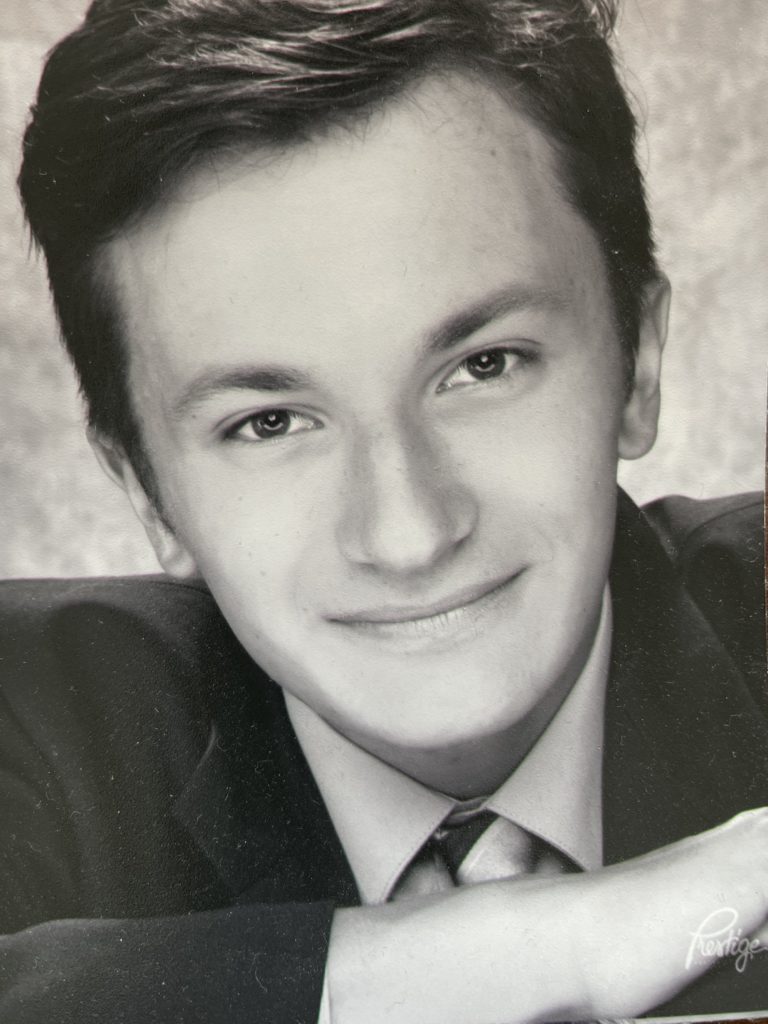
Andrew Silagi ’24
Andrew is majoring in Secondary English Education and minoring in Secondary History Education. He is from Arlington Heights, IL. We thank Dr. Christiana Salah (English) for her guidance with Andrew’s piece.
1 Edward Berdoe, Browning and the Christian Faith: The Evidences of Christianity from Browning’s Point of View (New York: Haskell House Publishers, 1970), xx.
3 Robert Browning, “Love among the Ruins,” in The Norton Anthology of English Literature, ed. Stephen Greenblatt, 10th ed. (New York: W. W. Norton and Company, 2018).
4 William Butler Yeats, “The Second Coming,” in The Norton Anthology of English Literature, ed. Stephen Greenblatt, 10th ed.(New York: W. W. Norton and Company, 2018).
5 Robert Adger Law, “The Background of Browning’s Love among the Ruins,” Modern Language Notes 37, no. 2 (1922): 312.
6 Browning, “Love among the Ruins,” lines 75-76.
7 Browning, “Love among the Ruins,” line 33.
8 Law, “The Background,” 313.
9 Browning, “Love among the Ruins,” line 81.
10 Browning, “Love among the Ruins,” line 84.
11 Second portion of quote (differentiated by single quotes) taken from Harold Bloom, Yeats (New York: Oxford University Press, 1970), 342. Whole quote taken from Richard P. Wheeler, “Yeats’ ‘Second Coming’: What Rough Beast?” American Imago 31, no. 3 (1974): 233.
12 Yeats, “Second Coming,” line 1.
13 Yeats, “Second Coming,” lines 19-20.
14 Yeats, “Second Coming,” lines 21-22.
15 Johnstone Parr, “The Site and Ancient City of Browning’s Love among the Ruins,” PMLA 68, no. 1 (1953): 130.
16 Parr, “Site and Ancient City,” 131.
17 Browning, “Love among the Ruins,” lines 2, 14, 19.
18 Paul D. Deane, “Metaphors of Center and Periphery in Yeats’ ‘The Second Coming,’” Journal of Pragmatics 24 no. 6 (1995): 628.
19 Yeats, “Second Coming,” line 4.
20 Yeats, “Second Coming,” line 6.
21 Browning, “Love among the Ruins,” lines 33-34.
22 Browning, “Love among the Ruins,” line 79.
23 Browning, “Love among the Ruins,” line 82.
24 Yeats, “Second Coming,” line 3.
25 Yeats, “Second Coming,” lines 7-8.
26 Yeats, “Second Coming,” line 4.
27 Yeats, “Second Coming,” line 7.
28 Browning, “Love among the Ruins,” line 80.


